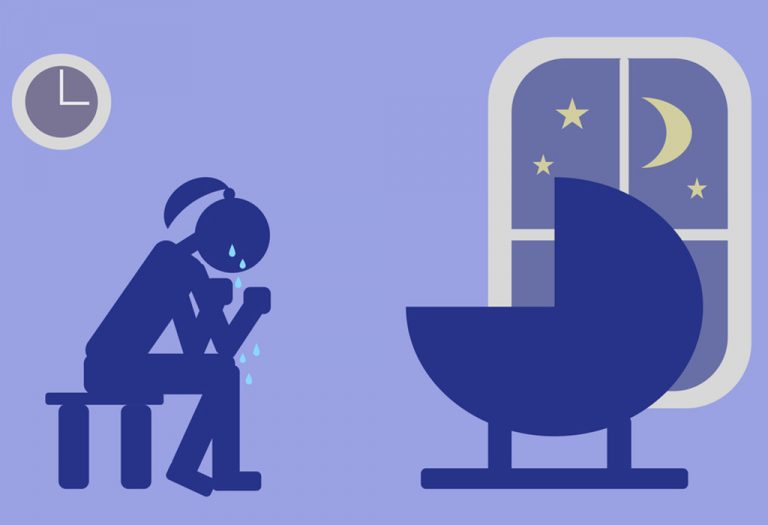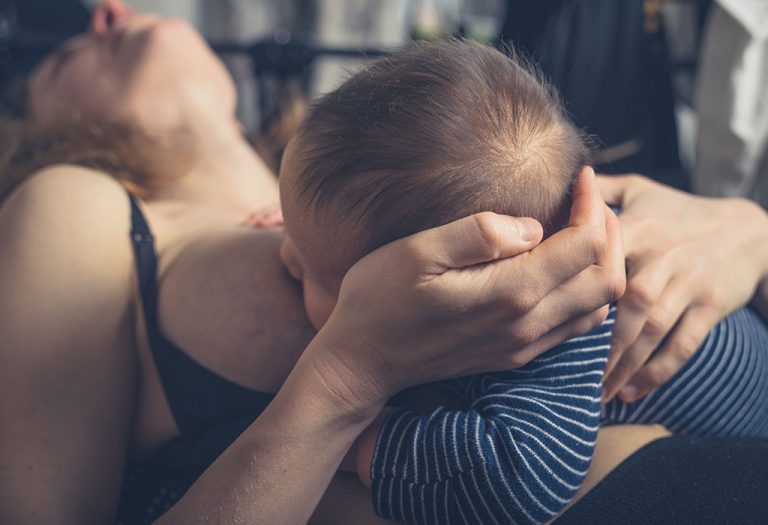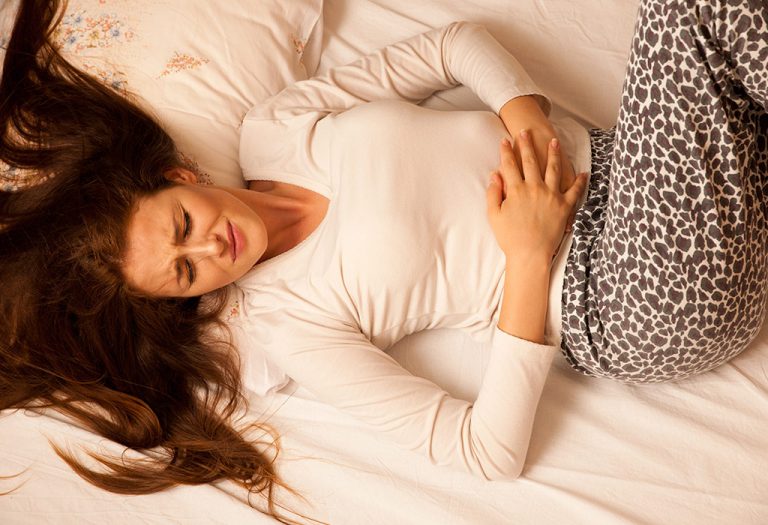12 Drastic Changes You’ll Notice in Your Vagina After Childbirth (C-section-too!) & 7 Ways to Tackle Them
- Changes You’ll Notice in Your Vagina After Childbirth
- Vaginal Care After Childbirth
- Does Your Vagina Go Back to Normal After Birth?
- FAQs
Post your baby’s birth, your body is bound to feel like it has gone through hell and back; after all, it did take quite a lot of literal blood, sweat, and tears (not to forget, screaming!) to dispel an entire human being out of your body. Things are going to feel sore and flaccid, and seeing as how everything ‘down there’ did most of the work during childbirth; there will be a lot of changes that you’ll experience with regard to your vagina. Vaginal changes after birth are real, and yes, this is also applicable to those moms who’ve had a C-section delivery! Panic is not; all the changes will return to normal within time. So, while it lasts, keep up with the knowledge to heal faster and better.
Changes You’ll Notice in Your Vagina After Childbirth
It’s not just childbirth that can bring about changes; your pregnancy may not have been super kind to your lady parts, too. Post delivery, your vagina is going to look and feel different; things may return to normal anytime between 12 weeks to within a year of childbirth. Although you can’t expect everything to be exactly the same as it used to be before you pushed a baby out of that tiny opening, your resilient vagina WILL return to normal in all its glory, battle scars, et al.!
In the Case of a Vaginal Delivery
When it comes to vaginal delivery, there’s no doubt that there will be plenty of changes, although it does depend on the individual. Some of these are also applicable to those who had a caesarean delivery.
1. Your Vagina is Going to Feel Super Sore
Stating the obvious, but it’s always good to remember to be kind to your body! Along with the vagina, the perineum (the area between the anus and the vagina) would also have faced strain if it underwent perineal tearing during childbirth, depending on the degree of the tear. As per the Royal College of Obstetricians and Gynaecologists, around 9 in every 10 first-time moms who give vaginal birth experience some graze, tear, or episiotomy. (1) In some cases, the doctor makes a small cut in the perineum area if the baby gets stuck on his way out, in a procedure known as an episiotomy (1); so that calls for plenty of healing time, too! Mayo Clinic suggests taking a sitz bath, using cooled witch hazel pads, or applying ice packs to the area for relief (2).
https://giphy.com/gifs/things-11SEOyfoyczY8U
Source: GIPHY.COM
2. It May Feel Dry for a Bit
The hormone estrogen helps to keep the vaginal tissue moist with a lubricating fluid. For the duration of your pregnancy, it keeps coursing through your body but drops suddenly after the birth of the baby. As a result, your vaginal tissue can just shrink, leading to dryness down there. Breastfeeding makes a difference here, too; while nursing, the estrogen levels in your body stay low and contribute to dryness. But no worries – once you’re done nursing, your vagina will return to its original hydrated state soon enough.
https://giphy.com/gifs/please-bored-anon-Ass7N88ITsb3a
Source: GIPHY.COM
3. Sex is Going to Be Uncomfortable
Yet another no-brainer! The thought of sex may not be extremely appealing to you after the less-than-entertaining physical exercise that childbirth was, which is okay. Do not panic or blame yourself if your libido or sex drive isn’t the same; you can perfectly blame it on childbirth, as NHS would also suggest (3). Sex after childbirth can be painful in the initial weeks or months owing to scar tissue and general aches and pains. Similarly, your orgasms may not be very intense after childbirth because of the weakening of the pelvic floor. But this dry phase won’t last for a lifetime; just be sure to take plenty of care (and by that, we mean lube, lube, and more lube!) and go slow.
https://giphy.com/gifs/work-everyday-lCB1VDBgnLx3a
Source: GIPHY.COM
4. The Stretch
Look, your vagina can stretch, and that was made pretty evident when your baby got through, wasn’t it! When it comes to pregnancy and childbirth, your body produces an aptly-named hormone called relaxin, which relaxes (surprise, surprise) the ligaments in the pelvic area and helps to widen the cervix. By doing so, your body prepares itself for all the stretching coming its way on D-day. But much like anything that has been stretched out and doesn’t really pop back into its previous shape and size, your vagina will feel more roomy post-delivery. It may take around 6 to 10 weeks easily for your vagina to return to its previous grandeur, but be prepared for some differences in shape and size!
https://giphy.com/gifs/greatbigstory-wow-omg-BLGlU7OWvFAFMoNjsM
Source: GIPHY.COM
5. It’s Going to Get a Little Too Messy!
There’s going to be a whole lot of stuff exiting your body once the baby’s out, and it’s going to last for a while. Lochia is the first thing you will notice – it’s the excess blood and tissue that helped your baby grow while in the womb and has no business staying inside your body anymore. As per Cleveland Clinic, you can expect lochia or discharge for about 4 to 6 weeks after the delivery (4). Mayo Clinic further adds that after 4 to 6 weeks, you should see less and less blood and discharge, which will eventually change colour from bright red to dark red and then to yellow or white to watery until it stops (2).
https://giphy.com/gifs/waterfall-beautiful-10olZ3QsdfXeSY
Source: GIPHY.COM
6. Visits to the Loo Can Be Unpredicted!
Going to the bathroom shouldn’t be a difficult task, but childbirth can make it so. Pooping may take ages, while peeing may not necessarily be confined to the privacy of the bathroom anymore – simple things like sneezing or laughing can make you feel a trickle run down your leg! Again, these are not ‘forever problems’, but urinary incontinence will need your immediate attention so that it can be solved as soon as possible. Mayo Clinic suggests going to the loo and pooping as regularly as you can without holding on for later, which will only trouble you later, eating fibre-rich food, and using stool softener under the doctor’s guidance will help you with a possibly much-less painful experience (2). March of Dimes adds in to suggest drinking plenty of water if faced with urinary problems (5).
https://giphy.com/gifs/heyarnold-hey-arnold-nicksplat-3ohjUMgaWXG19VJEBy
Source: GIPHY.COM
7. There’ll be Changes in the Vaginal Muscle Strength
Following childbirth, the vagina typically returns to its pre-pregnancy form and muscle strength, albeit with some minor loss in muscle tone. A study conducted by Johns Hopkins Medicine revealed that even ten years after vaginal childbirth, there can be a lingering impact on pelvic floor muscle strength (6). This could explain why some women may perceive a slight difference in sexual sensation after giving birth. Although the decline in strength is generally minimal, mothers can engage in exercises that aim to strengthen the vaginal muscles postpartum.
https://giphy.com/gifs/growwithjo-Ze2gjAuN8s034xHBQ6
Source: GIPHY.COM
In the Case of a C-section Delivery
If you thought your caesarean delivery exempted your vagina from changes, well, (*pats you on the back*), sorry! In these situations, the vagina does go through changes, but they may not all be because of the delivery; some of them may be due to the pregnancy itself.
1. Varicose Veins May Stick Around
During your pregnancy, increased blood flow to the vagina can result in some pretty large varicose veins, which ideally should go away after delivery. But that may not always happen, and with age and an increased number of pregnancies, they may increase.
2. Tenderness and Cramping
Your uterus would have gone from being the size of an orange to expanding to the size of a watermelon during your pregnancy. So of course, its return to its original state will result in some discomfort, tenderness, and cramping. These may feel like contractions, but don’t let it freak you out!
https://giphy.com/gifs/britney-spears-dislike-LRxugmH6BnAEE
Source: GIPHY.COM
3. There May be Swelling
The fluids administered to you during the surgery can lead to temporary swelling in the vagina, and sometimes the vulva too. Also, the excess fluids in the body often travel to the face and extremities of the body while you’re in labour, which can also explain any swelling you face.
4. The Vagina May Not Be as Tight as You Expected
Perhaps the only advantage you could think of when it came to the C-section ordeal was that your vagina would retain its tightness – but of course, that will prove to be a myth! It may look the same, but there will definitely be some looseness you experience, although it may not be of the same severity that women who go through a vaginal delivery experience. This is because, during labour, the muscles of the pelvic floor (which gives the vagina its structure, strength, and grip) stretch out. The fact that the baby’s head is thrust upon the cervix and vagina continuously while in labour can also cause pain once the delivery is done.
https://giphy.com/gifs/thismightget-PiiNM7VvxrRKgsZjW8
Source: GIPHY.COM
5. You May Expect Some Unwanted Soreness
Surprisingly, experiencing soreness isn’t exclusive to those who undergo vaginal delivery. Even if you delivered via cesarean section, vaginal examinations can cause swelling and tissue trauma that will require time for recovery. Fortunately, any swelling and discomfort in the vaginal area postpartum should gradually diminish with time.
Vaginal Care After Childbirth
For all the trouble it has gone through, your vagina deserves some TLC! Depending on the kind of delivery you’ve had, your doctor will provide you with any special advice that is applicable to you. Apart from that, here are a few things you need to do to maintain vaginal hygiene and strength post childbirth.
- Doctors and Mayo Clinic sing praises of Kegels for a good reason – doing these exercises during your pregnancy (and once you’re deemed ready for exercise after childbirth) is going to strengthen your pelvic floor muscles (7). It’s necessary to solve your problem of urinary incontinence and also ensures that the vagina becomes more toned. And remember how your orgasms could lose their intensity…you sure don’t want that as a long-lasting effect of childbirth, do you? Get to squeezing some muscles, then!
- Get acquainted with a Sitz bath, which is basically a shallow basin that you sit in, submerging your hips and buttocks only for about 20 minutes, a few times a day. If a Sitz bath seems inaccessible, you can rinse the area with lukewarm water 3 or 4 times a day to keep germs and infections at bay.
- The first poop will always be difficult, but it’s necessary to get it out! Try stool softeners prescribed by your doctors to ease the pain, according to the American Academy of Family Physicians (8). Since the area will be sore and passing urine could hurt, you can try spritzing lukewarm water (not into the vagina) while peeing, which can alleviate some level of discomfort.
- Whether you’ve gone through a vaginal or C-section delivery, stay clear of tampons to avoid any bacterial infection until your doctor says otherwise, as advised by the American Academy of Family Physicians (8). Invest in good, bulky sanitary pads because you’ll need them in plenty. Sometimes, certain pads with their formulae can cause allergic reactions, so make sure you switch brands if you feel any suspicious itching or see rashes.

- Pain relief medications are not prescribed for new mothers, but if your doctor allows you, try taking a mild painkiller once in a while. Of course, we repeat, subject to the doctor’s approval only! But what you can do for yourself is use ice packs to relieve yourself of pain – effective and risk-free!
- Sex MUST involve plenty of lube because it’s the only way you’re not going to feel bruised and hurt afterwards. It’s very important to hold off for the first six weeks after giving birth, after which you can get back in the game, albeit slowly and carefully. But hey, this leaves room for experimentation with your partner and who knows, you might discover something new you like!
- Discharge, bleeding, and contractions (or after-pains) are common after pregnancy for a while. But if you notice anything unusual, including the duration for which these last, it’s best to consult your doctor.
Does Your Vagina Go Back to Normal After Birth?
The answer to your question is – Yes and No. After childbirth, your vagina undergoes both temporary and lasting changes. While many of the initial alterations to the vagina and changes to the vulva after childbirth typically resolve during postpartum recovery, some effects may persist even after physical healing is complete. Over time, your vagina will return to its pre-pregnancy size and shape. However, factors such as episiotomy and resulting scar tissue can influence sensations, while healed tears and stitches might bring a slight change in appearance and colouration. Therefore, while the majority of changes are temporary, some aspects of your vagina may remain altered even after the recovery period.
FAQs
1. How long do postpartum vaginal changes typically last?
Vaginal changes after c-section or vaginal birth vary. However, most women with vaginal delivery may take 6 to 8 months or more to a year to recover fully, depending on their health or any complications that occurred during delivery.
Following a cesarean delivery (c-section), postpartum bleeding usually persists for several weeks, albeit potentially in lesser volume compared to vaginal delivery, according to Cleveland Clinic (9). The discharge initially appears as dark red and gradually transitions through shades of brown, yellow, and ultimately white over the course of several weeks.
2. When should women seek medical attention for vaginal changes after childbirth?
It’s no doubt that the vagina looks different after birth, and you feel different after giving birth. After childbirth, you might notice some pretty heavy bleeding for the first few days. It’s called lochia rubra, and it’s totally normal. But here’s the thing: if it’s like you’re soaking through a pad in less than an hour, that’s too much. That’s when you need to call your doctor. Secondly, if you’re still heavy bleeding or if you start feeling feverish with no other explanation, it could indicate endometritis. That’s when you should not delay getting a check-up. Bottom line: if you’re feeling off in any way, don’t hesitate to reach out to your doctor. It’s always better to be safe than sorry when it comes to postpartum (10).
It’s impossible to fathom how something SO small has SO much power, but that’s because we underestimate the fighting power of the heroine that is the vagina! Give it time, give it love and care, give it everything that the doctor ordered during pregnancy and after, and watch it prepare itself for all the challenges headed its way!
References/Resources:
1. Perineal tears during childbirth; Royal College of Obstetricians & Gynaecologists; https://www.rcog.org.uk/for-the-public/perineal-tears-and-episiotomies-in-childbirth/perineal-tears-during-childbirth/
2. Postpartum care: What to expect after a vaginal birth; Mayo Clinic; https://www.mayoclinic.org/healthy-lifestyle/labor-and-delivery/in-depth/postpartum-care/art-20047233
3. Low sex drive (loss of libido); NHS; https://www.nhs.uk/conditions/loss-of-libido/
4. Pregnancy: Physical Changes After Delivery; Cleveland Clinic; https://my.clevelandclinic.org/health/articles/9682-pregnancy-physical-changes-after-delivery
5. Your body after baby: The first 6 weeks; March of Dimes; https://www.marchofdimes.org/find-support/topics/postpartum/your-body-after-baby-first-6-weeks
6. Friedman. S, Blomquist. J. L, et al.; Pelvic Muscle Strength After Childbirth; Johns Hopkins Medicine; https://www.hopkinsmedicine.org/-/media/gynecology-obstetrics/documents/medical-services-gynecology_obstetrics/pelvicmusclestrength_summary.pdf; October 2012
7. Kegel exercises: A how-to guide for women; Mayo Clinic; https://www.mayoclinic.org/healthy-lifestyle/womens-health/in-depth/kegel-exercises/art-20045283
8. Recovering from Delivery (Postpartum Recovery); American Academy of Family Physicians; https://familydoctor.org/recovering-from-delivery/
9. Lochia; Cleveland Clinic; https://my.clevelandclinic.org/health/symptoms/22485-lochia
10. Lopez-Gonzalez. D. M, Kopparapu. A. K; Postpartum Care of the New Mother; StatPearls Publishing; https://www.ncbi.nlm.nih.gov/books/NBK565875/
Also Read:
Your First Period After Having a Baby
How to Treat Postpartum Urinary Incontinence?
Simple Things You Can Do to Make Your Vagina Happy!
Causes and Treatment for Vaginal Dryness After Childbirth
Was This Article Helpful?
Parenting is a huge responsibility, for you as a caregiver, but also for us as a parenting content platform. We understand that and take our responsibility of creating credible content seriously. FirstCry Parenting articles are written and published only after extensive research using factually sound references to deliver quality content that is accurate, validated by experts, and completely reliable. To understand how we go about creating content that is credible, read our editorial policy here.























